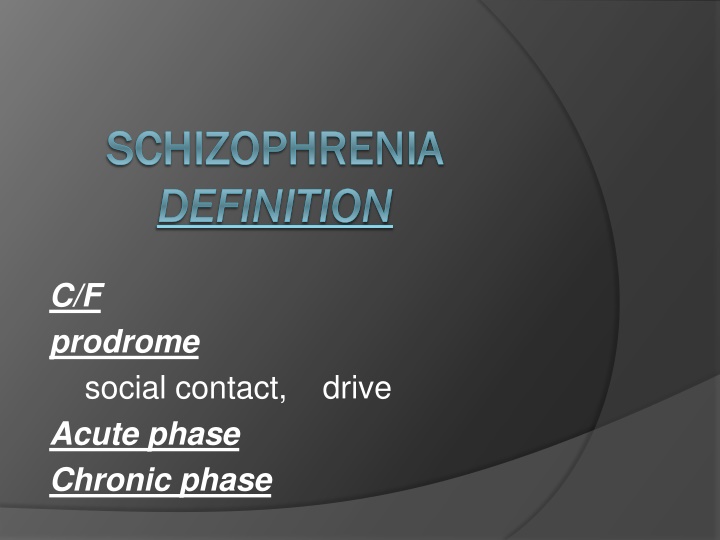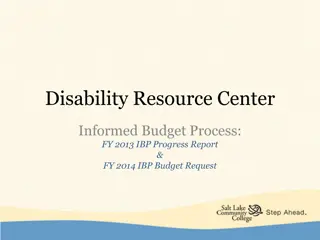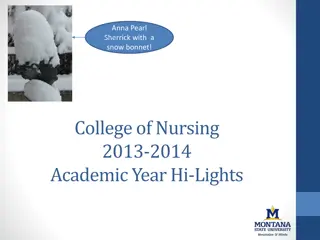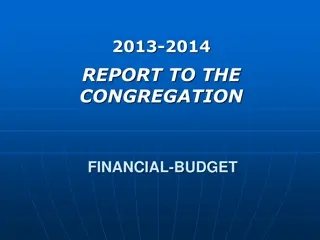
Schizophrenia: Symptoms, Phases, and Prognosis
Explore the definition of schizophrenia, its acute and chronic phases, diagnosis, prognosis, epidemiology, factors influencing prognosis, and etiology. Learn about the symptoms, behaviors, and challenges associated with this mental health condition.
Download Presentation

Please find below an Image/Link to download the presentation.
The content on the website is provided AS IS for your information and personal use only. It may not be sold, licensed, or shared on other websites without obtaining consent from the author. If you encounter any issues during the download, it is possible that the publisher has removed the file from their server.
You are allowed to download the files provided on this website for personal or commercial use, subject to the condition that they are used lawfully. All files are the property of their respective owners.
The content on the website is provided AS IS for your information and personal use only. It may not be sold, licensed, or shared on other websites without obtaining consent from the author.
E N D
Presentation Transcript
SCHIZOPHRENIA SCHIZOPHRENIA DEFINITION DEFINITION C/F prodrome social contact, Acute phase Chronic phase drive
acute phase acute phase appearance and behavior withdrawal,perplexity,violance, posturing Affect suspiciosness,bewilderment, incongruent Speech ununderstandable ,irrelivant,incoherent
Acute phase Thought Form, lack of association knight moves neologisms derailment content, delusions primary secondary
Acute phase Perception auditory hallucination,commentory,3rd thought echo Self experience Thought interference Broadcasting Withdrwal Insertion Passivity, made action, impulse, feeling, somatic sensation
Chronic phase Chronic phase Mainly negative symptoms Lack of volition Poverty of affect Poverty of speech Ventricular enlargement Poor response to narcoleptics Poor prognosis
Epidemiology Epidemiology 25-40 men=women 1%
Diagnosis Diagnosis Schnieder`s first rank ICD 1O DSM IV Subtypes paranoid disorgenized catatonic
DDx DDx Depression Mania Delusional disorder Drugs Medical conditions
Prognosis Prognosis 20% recover 35% relapsing no symptoms between 20% relapsing symptoms between 20% down since start 10% suicide
Factors of prognosis Factors of prognosis Onset Event Family history Premorbid personality Affective symptoms EE IQ Ventricle size Positive or negative culture
Etiology Etiology genetic factors 60 % no family history one parent two parents mono twines di twins
Etiology Etiology environmental factors Season of birth, Influenza, Birth trauma Biological dopamine hypothesis brain changes
Etiology Etiology social factors shizophrenic mother schism skew double bind social class
Management Management Admission Violent patient Drugs
Phenothiazines Aliphatic chlorpromazine ( largactile) Piperdines thioridazine ( melleril) Piprazines trifluorperazine(stelazine) , fluphenazine N/B fluphenazine decanoate (modecate) Actions Antidopaminergic anticholenergic antiserotoninergic, antiadrenergic
Management SE early hrs intermediate days late months Butyrophenones, haloparidol Atypicals resperdone clozapine , olanzapines ECT
Management of chronic phase Management of chronic phase Relapse prevention, atypicals Rehabilitation Services
Relapse prevention Relapse prevention Drugs EE Events Social asylum vs. community




















